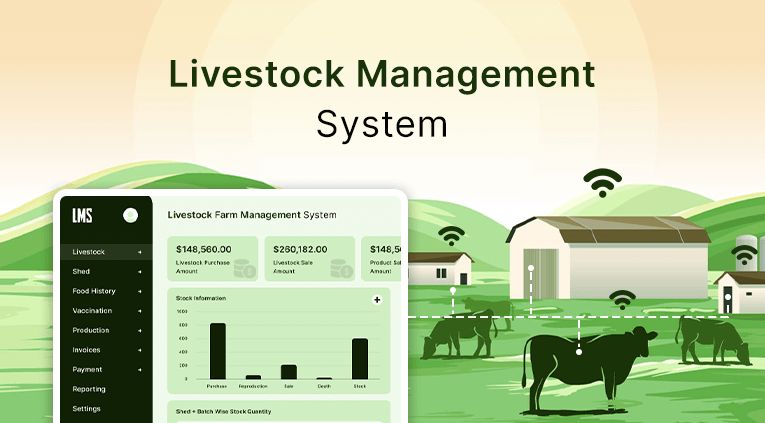The healthcare industry is entering a new era of digital transformation. As technology advances, the potential for streamlining operations and improving patient care is becoming increasingly evident. One area where this has become especially clear is with patient portal software (PPS). PPS provides patients with secure online access to their medical records, allowing them to view information such as lab results, medications, and appointment reminders.
As patients are also becoming more tech-savvy, they can take more control of their personal health information and make informed decisions about their care. If you plan to build a custom patient portal to unlock better healthcare, this article is for you. let’s begin our article with important statistics you need to know.
Patient Portal Software Statistics
According to reports, the global patient portal market was valued at around $2.41 billion in 2021, and it’s all set to touch the mark of around $11.74 billion by the end of 2030.
More than 90% of hospitals offer platforms to view their basic treatment details, but only 30% of them use them actively.
The patient portal industry is expected to grow with a CAGR of around 7.6% between 2019 and 2027.
Also Read: Elaborating The Revolution In Healthcare Industry
These statistics are evident that this market is growing significantly and will continue to grow in the future. That means if you’re planning to invest in a custom patient portal for your healthcare organization, plenty of opportunities are available for you. Now, let’s understand more about PPS.
What is Patient Portal Software?
In the vast ecosystem of trending healthcare technology, patient portal software plays a pivotal role. It’s akin to a digital gateway, a secure online portal that provides patients with 24/7 access to their personal health information from anywhere with an internet connection. This cutting-edge tool allows patients to manage various aspects of their healthcare, such as scheduling appointments, viewing medical records, and communicating directly with healthcare providers.
It’s worth noting that this software often forms an integral part of a broader system, such as electronic medical records (EMR) or electronic health records (EHR) systems. It enhances the efficiency of these systems by providing a user-friendly platform for patients to interact with their healthcare data. This way, it plays an instrumental role in bridging the gap between patients and healthcare providers, fostering improved communication, and promoting patient engagement.
The benefits of patient portal software are manifold. Beyond its primary function of providing access to medical records, it also offers a host of other services. These may include prescription refills, educational materials, billing and payment options, and more. By centralizing these services, the software streamlines the healthcare management process for patients, making it easier for them to stay on top of their health and wellness. Now, let’s check out different types of patient portal software available in the market.
Types of Patient Portals Software
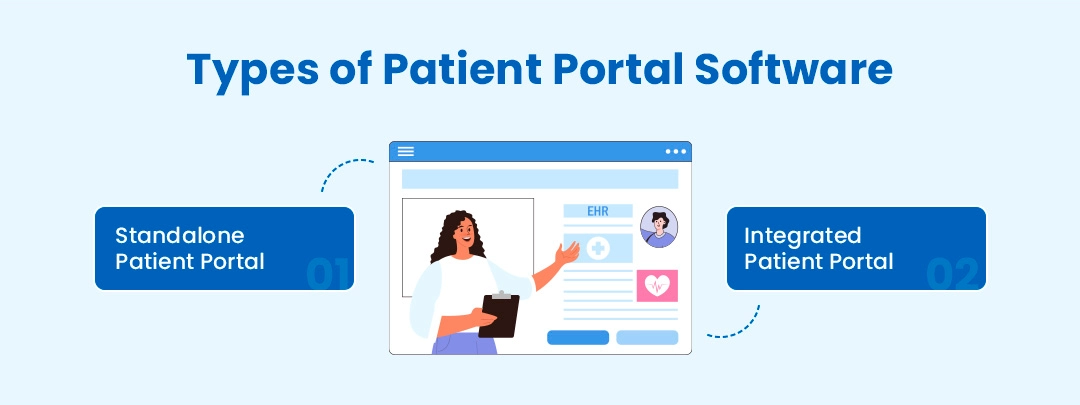
Standalone Patient Portal
A standalone patient portal is a type of patient portal system that operates independently, separate from any other healthcare system. It’s designed with simplicity in mind, which means it has a straightforward software architecture that requires less investment and effort in terms of development, as reported by Tateeda. This kind of system is often chosen by physicians who want a system that works independently without needing integration with other systems, as noted by Digital Health Folio3.
Also Read: Remote Patient Monitoring Systems
Standalone patient portals come with various features that help both healthcare professionals and patients. Some of these features include access to health records and patient data, appointment scheduling, prescription request/refill, and direct contact with healthcare professionals, according to Digiteum.
Despite its simplicity, a standalone patient portal can provide comprehensive services that enhance the patient’s healthcare experience. It’s an innovative tool that revolutionizes delivering and receiving healthcare, promoting efficiency, convenience, and patient empowerment.
Integrated Patient Portal
In the rapidly evolving world of healthcare, the Integrated Patient Portal (IPP) has emerged as a significant tool to streamline patient care. The IPP is not just a digital platform but a conduit connecting patients directly to their medical records and healthcare providers. This revolutionary tool is designed to provide a seamless experience, allowing patients to view and request appointments, retrieve test results, update demographic information, and more, all from the comfort of their homes.
Moreover, the Integrated Patient Portal goes beyond being a mere repository of health records. It’s a comprehensive system that enables concierge-level home care services, facilitating superior communication with healthcare specialists. Whether you need access to lab results, wish to request appointments, or want to communicate directly with your doctor, the IPP serves as a one-stop shop for all these needs.
This technological marvel is transforming the healthcare landscape, making patient care more personalized, accessible, and efficient.
Benefits of Patient Portal Software
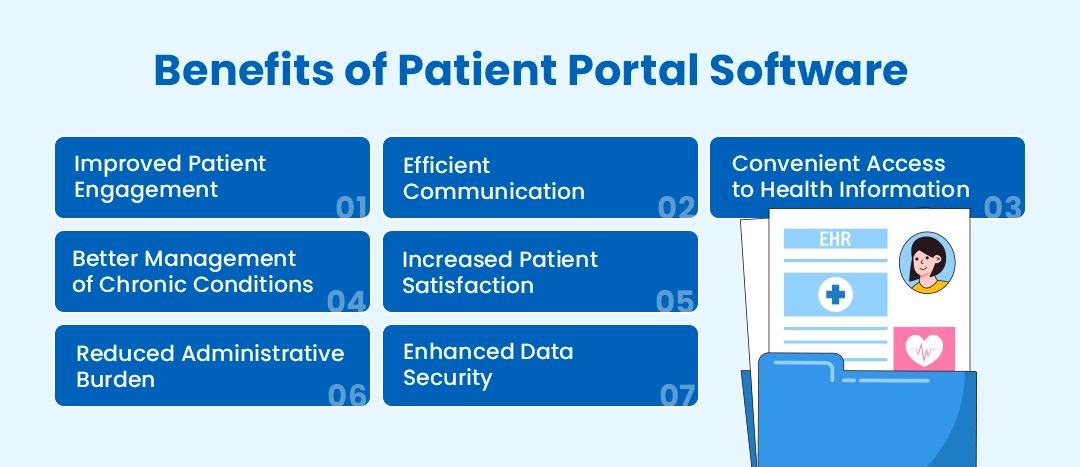
Improved Patient Engagement
A patient portal allows patients to be more involved in their own healthcare. They can view their medical history, and schedule appointments, request prescription refills, and communicate directly with their healthcare providers. This leads to higher levels of engagement, which can improve overall health outcomes.
Efficient Communication
With a patient portal, communication between patients and healthcare providers is streamlined. Patients can send messages at any time, and providers can respond at their convenience. This eliminates the need for phone tag and reduces the chance of miscommunication.
Convenient Access to Health Information
A patient portal provides easy access to vital health information, such as lab results, medication lists, and medical histories. Patients no longer need to wait for a phone call or letter – they can simply log in to their portal to access this information.
Better Management of Chronic Conditions
For patients with chronic conditions, a patient portal can be an invaluable tool. It allows them to track their symptoms, monitor their progress, and share this information with their healthcare providers. This can lead to better management of chronic conditions and improve quality of life.
Increased Patient Satisfaction
When patients have access to their health information and can easily communicate with their health providers, they tend to be more satisfied with their care. This can lead to increased patient retention and positive word-of-mouth referrals for the healthcare provider.
Reduced Administrative Burden
Patient portal software can significantly reduce the administrative burden on healthcare staff. Tasks like scheduling appointments, refilling prescriptions, and answering patient questions can be handled online, freeing up staff to focus on other important tasks.
Enhanced Data Security
Patient portal software provides a secure platform for storing and sharing health information. This can help healthcare providers comply with data privacy regulations and protect their patient’s sensitive information.
There are several benefits of developing custom patient portal software solutions and gaining an edge. Before you embark on the journey, let’s explore some must-have features.
Must-have Features of Patient Portal Software
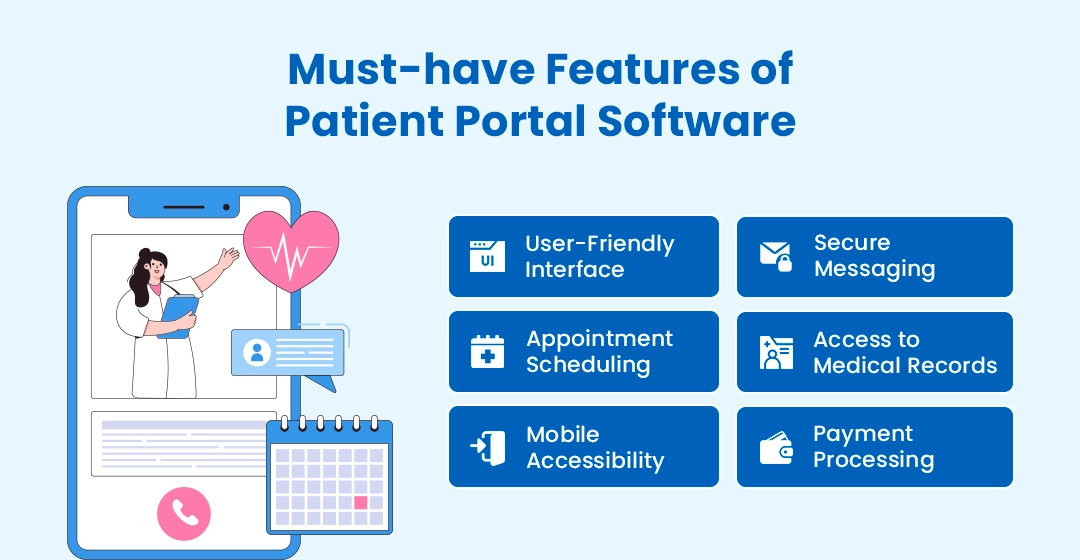
User-Friendly Interface
A patient portal software must prioritize user experience. It should be easy to navigate, even for patients who are not tech-savvy. A clean, intuitive layout with clear instructions can make all the difference. Patients should be able to find what they need quickly and easily, without having to click through numerous pages or sift through irrelevant information.
The interface should be designed with the patient in mind, focusing on their needs and how they will interact with the system. This includes large, easy-to-read fonts, simple navigation menus, and clear call-to-action buttons. The design should also be consistent across all pages to avoid confusion.
Secure Messaging
Secure messaging is a crucial feature of any patient portal software. This allows patients to communicate with their healthcare providers safely and efficiently. They can ask questions, discuss symptoms, request prescription refills, and more, all without having to make a phone call or visit the office in person.
This feature not only improves patient satisfaction but also increases efficiency for healthcare providers. It reduces the need for phone calls and allows providers to respond to messages at their convenience. To ensure security, all messages should be encrypted and comply with HIPAA regulations.
Appointment Scheduling
An essential feature of any patient portal software is the ability to schedule appointments online. This functionality should be straightforward and easy to use. Patients should be able to view available time slots, choose their preferred time, and book an appointment with just a few clicks.
This feature saves both the patient and healthcare provider time. It eliminates the need for back-and-forth phone calls and allows patients to schedule appointments at their convenience. The system should also automatically send reminders to patients to reduce the number of missed appointments.
Access to Medical Records
Patients should have easy access to their medical records through the patient portal software. This includes lab results, medical history, medications, allergies, and more. Having this information readily available empowers patients to take an active role in healthcare.
Access to medical records also improves communication between patients and healthcare providers. Patients can easily reference their records when discussing their health with their providers. This feature must be secure to protect sensitive patient information.
Mobile Accessibility
In today’s digital age, mobile accessibility is a must. Patients should be able to access the patient portal software from any device, including smartphones and tablets. This makes it easier for patients to manage their health on the go.
Mobile accessibility also increases engagement with the patient portal. Patients are more likely to use this portal if they can easily access it from their mobile devices. The mobile version of the portal should include all the same features as the desktop version and be equally as user-friendly.
Payment Processing
Patient portal software should include a secure, easy-to-use payment processing system. Patients should be able to view and pay their bills online, set up payment plans, and store payment information for future use. This makes it easier for patients to manage their healthcare expenses and reduces administrative work for healthcare providers.
To create the best patient portal software for hospitals, you need to know the development process inside out. To help you understand it better, we’ve divided the process into simple steps.
The Development Process of a Custom Patient Portal Software
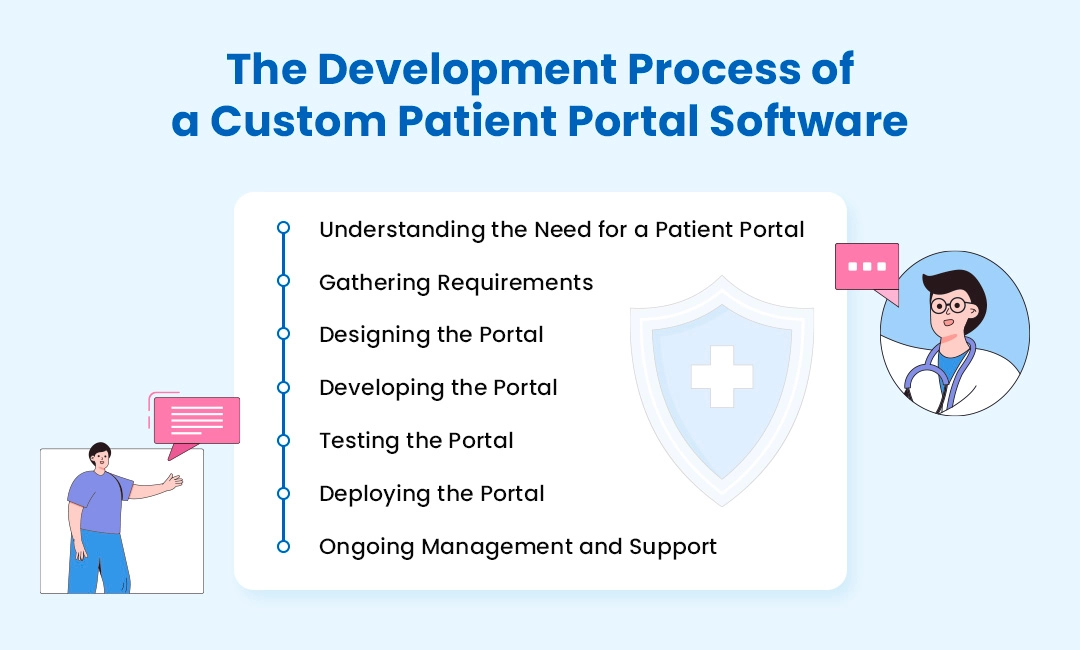
Understanding the Need for a Patient Portal
Before diving into the development process, it’s important to understand why a custom patient portal is necessary. A patient portal is an online tool that allows patients to access their health information, communicate with their healthcare providers, schedule appointments, refill prescriptions, and more. This tool can significantly improve the patient experience, provide convenience, and enhance communication between patients and providers.
Gathering Requirements
The first step in developing a custom patient portal is to gather requirements. This involves understanding the needs and expectations of the end-users, which are the patients and the healthcare providers. The requirements should over the functionalities and features of the portal, such as secure messaging, appointment scheduling, prescription refills, access to medical records, and more.
Designing the Portal
Once the requirements are gathered, the next step is to design the portal. The design should be user-friendly and intuitive to ensure use for all users, regardless of their technical skills. This includes designing the interface, navigation, layout, and overall aesthetics of the portal.
Developing the Portal
After the design phase, the development phase begins. This involves coding the portal and implementing the features and functionalities outlined in the requirements. It’s crucial to follow best practices in software development to ensure the portal is secure, efficient, and reliable.
Testing the Portal
Once the portal is developed, it needs to be thoroughly tested before it’s deployed. This includes functional testing to ensure all features work as expected, usability testing to ensure the portal is easy to use, security testing to ensure the portal is secure and protects patient information, and performance testing to ensure the portal can handle the expected load.
Deploying the Portal
After testing, the portal is ready for deployment. This involves setting up the portal in the live environment, configuring the necessary settings, and ensuring its integrated correctly with other systems, such as the hospital’s electronic health record (EHR) system.
Ongoing Management and Support
After the portal is deployed and users are trained, ongoing management and support are required. This includes providing technical support to users, managing updates and upgrades to the portal, monitoring the portal’s performance and usage, and continuously improving the portal based on user feedback and evolving needs.
Now, let’s explore how much it costs to build custom patient portal software for your users. Understanding the cost factor is a crucial part of planning for the portal’s development.
How Much Does it Cost To Build a Patient Portal Software?
The cost of building a custom patient portal software depends on several factors, such as the size and complexity of the project, the development team’s experience and skills, and the tools used. It can range between $25,000 to $65,000. A more complex app with more functionality can cost up to $1,25,000.
When budgeting for your project, it’s important to consider not only the upfront cost of building the portal but also the ongoing costs associated with its maintenance and support. This includes hosting fees, licensing fees for third-party tools used in development, and developers costs for system administrators and technical support staff.
Factors Affecting the Cost of Building a Patient Portal Software
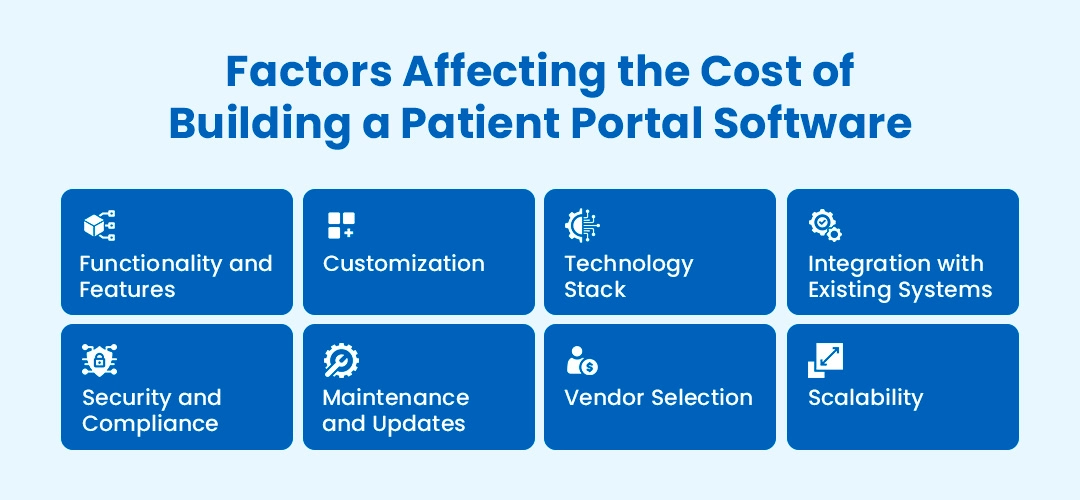
Functionality and Features
The number and complexity of features you want in your patient portal software will significantly influence the cost. Basic features like appointment scheduling, prescription refills, and access to medical records are standard in most software. However, if you want more advanced features like telemedicine, integration with wearable devices, or AI-powered health insights, the cost will undoubtedly increase. Every extra feature requires additional development time, resources, and expertise, all of which contribute to the overall cost.
Customization
Customization is another critical factor that influences the cost. If you want a patient portal software that aligns with your specific needs and those of your patients, you’ll likely need to invest more than if you opted for an out-of-the-box solution. Customization can include modifying the software’s interface to match your branding, adding or removing features, integrating with existing systems, or even building a completely bespoke system.
Technology Stack
The technology stack used in patient portal development services will also influence the cost. Some technologies are more expensive to use or require more specialized skills than others. The choice of technology can also impact future costs; for example, some technologies might be cheaper to implement initially but more expensive to maintain in the long run.
Integration with Existing Systems
Integration with existing systems like electronic health records (EHRs), practice management systems, or billing software can add complexity to the project and therefore increase the cost. These integrations are crucial for ensuring seamless data flow and enhancing the user experience but require skilled developers to implement correctly.
Security and Compliance
Security and compliance are paramount in healthcare IT. Patient portal software must comply with regulations like the Health Insurance Portability and Accountability Act (HIPAA) in the U. S. or the General Data Protection Regulation (GDPR) in the EU. Ensuring compliance during development can be time-consuming and costly, but it’s necessary to protect patient information and avoid hefty fines.
Maintenance and Updates
Building software is just the beginning. To ensure it stays secure, functional, and up-to-date, you’ll need to budget for ongoing maintenance and updates. This might include fixing bugs, updating software components, implementing new features, and ensuring continued compliance with changing regulations.
Vendor Selection
The cost of building a patient portal software can also vary significantly depending on the vendor you choose. Some vendors offer comprehensive solutions that cover everything from development to maintenance and training, while others may only provide specific services. The vendor’s location can also affect the cost, with developers in certain regions typically charging more than those in others.
Scalability
If you anticipate your practice growing or your needs evolving over time, you’ll want to ensure your patient portal software can scale to meet these changes. Building a scalable solution might require more upfront investment but can save you from costly overhauls or replacements in the future.
It’s important to hire an experienced development company like AGS that understands the unique challenges of healthcare IT. They should be able to help you build a safe, secure, and reliable patient portal software that meets your needs today and can adapt to changes in the future.
Why Hire Auxano Global Services for Patient Portal Software Development?
AGS is a trusted and reliable patient portal development company with years of experience in healthcare app development. Our developers have a deep understanding of healthcare protocols and regulations, so they can help you build a secure and compliant solution that meets all the necessary requirements. Plus, we provide continuous post-launch support to ensure your patient portal software remains up-to-date with the latest features.
With AGS, you’ll get comprehensive services that cover everything from development to deployment and maintenance. Our team is available 24/7, so you can always count on us for help when needed.
Wrapping Up!
You can unlock better health care by developing modern patient portal software. It should be secure, reliable, and compliant with all the necessary regulations. An experienced development company like AGS can help you build a solution that meets your needs and provides an excellent user experience.

By leveraging the latest technologies, you can create a platform that makes it easier for patients to access care while also reducing deployment costs and improving the overall security of your data.
Frequently Asked Questions
-
1. What is Patiеnt Portal Softwarе?
Patiеnt portal softwarе is a wеb-basеd platform that facilitates sеcurе and reliable communication bеtwееn patients and healthcare providers. It assists patients in managing their health by providing access to their medical records, appointmеnt schеduling, and much more.
-
2. What аrе thе Kеy Fеaturеs of Patient Portal Software?
Key fеaturеs of patient portal software include access to personal health records, appointmеnt schеduling, prеscription rеfills, billing and paymеnt systеms, sеcurе messaging with healthcare providers, and health education resources. Sоmе portals may also include telemedicine fеaturеs for virtual consultations.
-
3. How Does Patient Portal Software Benefit Healthcare Providers?
Patiеnt portal softwarе can strеamlinе administrativе tasks, improve patient engagement, еnhancе communication, rеducе no-shows, and еnablе bеttеr patiеnt carе. By providing direct access to health information, it encourages patients to take an active role in their healthcare, leading to better outcomes.
-
4. What Should be Considered When Developing a Patient Portal Softwarе?
When developing patient portal software, considеrations should include intuitivе UX, sеcurity, compliancе with hеalthcarе rеgulations, intеgration with еxisting systеms, customization options, and scalability for future growth.
-
5. What is the Future of Patient Portal Software Dеvеlopmеnt?
The future of patient portal software development is likely to be driven by advancements in technology and increasing demand for rеmotе healthcare services. This could include more advanced telemedicine fеaturеs, integration with wearable devices for rеal-timе health monitoring, and predictive analytics to assist in personalized care.





